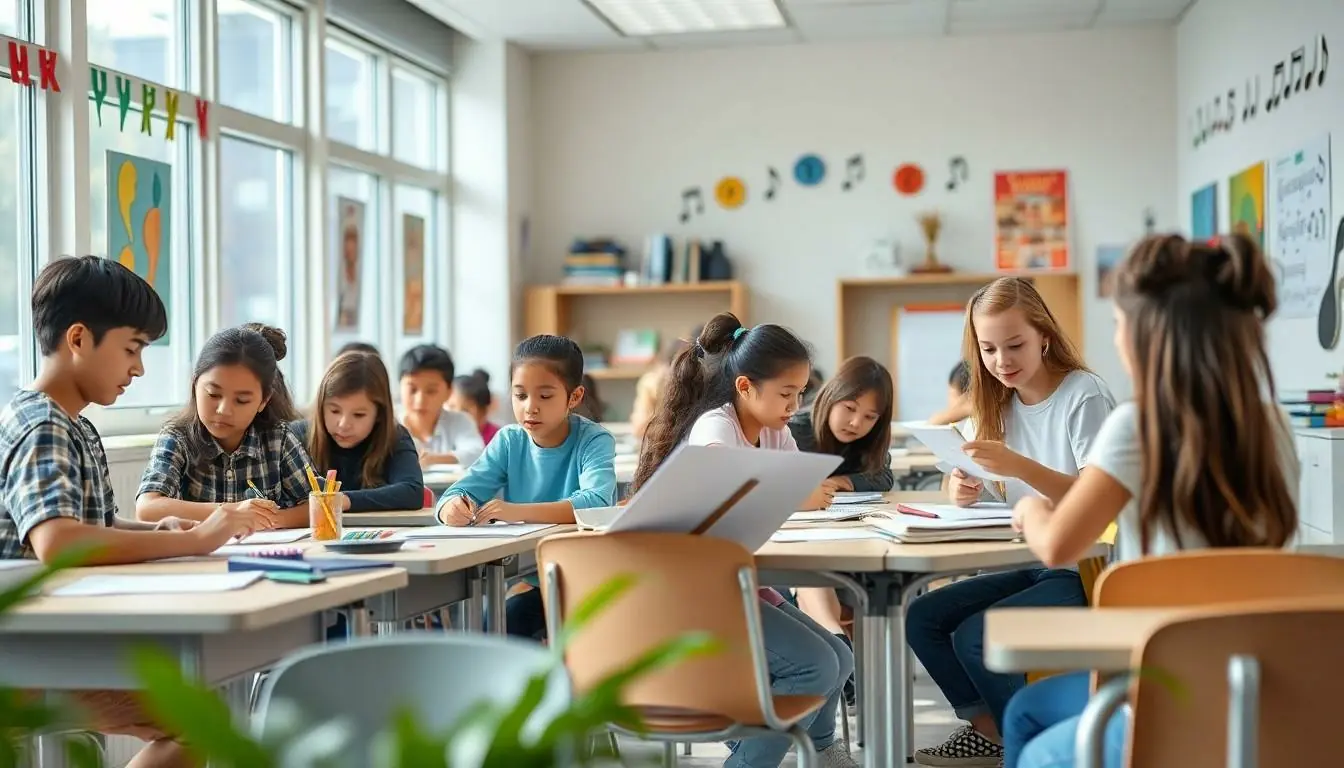Imagine walking into a classroom where the air is filled with the sounds of Beethoven’s symphonies instead of the usual chatter. Classical music isn’t just for concert halls; it can transform the learning environment into a haven of focus and creativity. With the right playlist, students might just swap their daydreams for daydreams of Mozart and Bach, making learning as harmonious as a well-tuned orchestra.
Incorporating classical music into the classroom isn’t just a whimsical idea; it’s backed by research that shows how it can boost concentration and enhance memory. So why not trade the traditional background noise for a little Tchaikovsky? It’s time to let the classics serenade students into a world of knowledge, where every note inspires curiosity and every rest fuels imagination. After all, who wouldn’t want to study algebra while channeling their inner virtuoso?
Table of Contents
ToggleThe Importance of Classical Music in Education
Incorporating classical music in education enhances the learning environment significantly. Research indicates that music from composers like Beethoven and Mozart fosters a more focused atmosphere.
Benefits for Cognitive Development
Classical music contributes to cognitive development in multiple ways. It helps improve memory retention, which aids students in processing and recalling information better. Engaging with complex compositions can also enhance critical thinking skills. Studies show that students exposed to classical music during study sessions perform better on tests. Incorporating music into lessons can spark creativity, encouraging students to think outside the box. Overall, classical music offers valuable support for learning different subjects and concepts.
Emotional and Social Growth
Emotional and social growth benefits from classical music in the classroom. Listening to music can help students manage stress and anxiety, promoting a calmer learning environment. This leads to improved focus and better interactions among peers. Music encourages collaboration during group activities, enhancing communication skills within social settings. Moreover, exposure to various compositions fosters appreciation for diverse cultures and perspectives. Thus, integrating classical music develops essential life skills alongside academic achievements.
Implementing Classical Music in the Classroom

Integrating classical music into educational settings can significantly enhance the learning environment. This incorporation involves selecting the right pieces and employing effective strategies.
Choosing Appropriate Pieces
Selecting the right classical compositions plays a crucial role in creating the desired classroom atmosphere. Focus on pieces that match the intended learning objectives. For concentration, try Beethoven’s “Piano Sonatas” or Mozart’s “Symphonies.” Use Tchaikovsky’s “Nutcracker Suite” for fostering creativity during activities. Consider varying tempos and moods, as different students resonate with diverse styles. Research shows that softer, slower pieces aid concentration, while more energetic music can boost motivation. Curate playlists based on specific classroom activities to maximize impact.
Strategies for Integration
Implementing classical music can take several forms within the classroom. Play tracks during independent work periods to encourage focus. Use interludes of music between subjects to create a smooth transition. Engage students with active listening sessions, discussing composers and compositions for added context. Pair music with visual art projects to inspire creativity through multimedia experiences. Experiment with background music during tests to ease anxiety and improve performance. Establish a routine where classical music becomes a regular part of the learning process, fostering a deeper appreciation over time.
Case Studies and Success Stories
Incorporating classical music in the classroom has proven successful across various educational institutions. Many schools achieve remarkable outcomes by utilizing these compositions.
Schools that Excel
Some institutions consistently demonstrate enhanced student performance when classical music is included. For example, a district in Michigan reported a 30% increase in test scores after integrating Mozart’s symphonies during study sessions. Another school in California implemented Beethoven’s piano sonatas during quiet work time, leading to improved focus and reduced distraction among students. Results like these underline the effectiveness of classical music in fostering an engaging learning environment.
Impact on Student Engagement
Research highlights a significant rise in student engagement linked to classical music. Schools utilizing Tchaikovsky’s “Nutcracker Suite” during art classes noted creativity and participation levels soared. Teachers observed students expressing their thoughts more freely during discussions, feeling inspired by the music. Engagement soared, resulting from both active listening and emotional connection to the compositions. Schools implementing these strategies report higher retention rates and improved academic motivation, reinforcing the benefits of classical music in education.
Challenges and Considerations
Integrating classical music into the classroom faces several challenges that educators must navigate.
Resistance from Educators
Some educators express skepticism about the effectiveness of classical music. It can stem from worry about distracting students instead of enhancing focus. Additionally, misconceptions about music’s impact on learning may hinder adoption. Teachers often prioritize traditional methods and may hesitate to change their established routines. Addressing these concerns through workshops and professional development can foster understanding. Research supporting the benefits of classical music, such as improved memory retention and concentration, can also help in reducing resistance.
Budget and Resource Constraints
Schools often operate within tight budgets that limit resources for music programs. Limited funding might lead to fewer opportunities for purchasing quality equipment or licensed music materials. Concrete examples show school districts struggling to balance various educational needs. Some institutions invest in music integration but lack proper support for implementation. Allocating funds for music initiatives can contribute positively to student learning experiences. Collaboration with local arts organizations might also provide access to resources and programs that enhance the use of classical music in the classroom.
Incorporating classical music into the classroom offers numerous advantages that extend beyond mere enjoyment. It fosters an environment conducive to concentration and creativity while enhancing cognitive development and emotional well-being. As educators embrace this powerful tool, they can witness firsthand the positive impact on student engagement and academic performance.
By implementing practical strategies and selecting appropriate compositions, teachers can seamlessly integrate classical music into their daily routines. This not only enriches the learning experience but also cultivates a deeper appreciation for the arts. As schools continue to explore innovative ways to enhance education, classical music stands out as a vital resource for nurturing well-rounded students ready to thrive in an ever-changing world.


